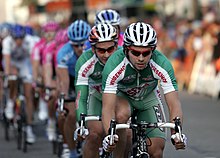Peloton (cycling)

Peloton (from French: pelote = ball) describes the closed main field of racing cyclists in road cycling .
While the term main field is defined at least in the area of the German cycling association BDR in connection with lapping criteria and circuit races , the use of the word in sports journalism and in public is sometimes vague: Depending on the course of the race, the largest group of drivers, but also a larger group , is included as the peloton called the favorite of the race.
Fundamental meaning
Due to the paramount importance of air resistance - with the exception of extreme inclines - as the largest component of the performance to be provided by the rider , in cycling, the use of the slipstream is predominantly used in large groups. It is started in a mass start and the field of drivers usually remains closed for the first few kilometers of the race. Since the slipstream of the person in front is sought because of the air resistance, the distance to the person in front is usually between 20 cm and 2 m. The lateral distance is 20 cm to 1 m.
Reference point in the course of the race
In the further course of the race - mostly on difficult sections of the route such as inclines, crosswind sections ( wind edge ), winding bends or narrow streets, etc. The like - there are so-called " breakaway attempts " ("attacks"), in the course of which individual drivers and more or less small groups try to break away from the main field. The race and group constellations change accordingly frequently.
The reaction to attacks in the peloton is different: The teammates of the breakaway drivers try to slow down the peloton by braking and prevent it from catching up, while the opposing teams try to “close the hole”, ie to close the gap.
As with these tactical maneuvers, the peloton is the most important reference point for the drivers at the end of the race. Suspended riders try to keep up with the peloton for as long as possible and, if necessary, to catch up again. If this does not succeed, long intervals are inevitable. In stage races with long mountain passages, the sprinters who are weak in the mountains gather in a "second peloton", the so-called " Gruppetto ", in order to avoid larger residues and thus avoid being excluded by exceeding the waiting period .
Control of the main field by the captains
In cycling, people do not only ride “against each other”. Alliances of convenience - in breakaway groups like in the peloton - are the order of the day. How this happens depends on the unwritten laws of cycling - such as food consumption during the so-called catering check , a fall or a defect in one of the favorites, driving through town in the "home" of individual riders - all that is required is a brief consultation between the captains to make the main draw throttle to a moderate speed.
Sprint trains
In the finals of one-day races or stages of tours , it is up to the so-called sprint trains (Italian: treni ) of the sprint specialists, i.e. the three to six fastest and most fast-paced team helpers, to keep the peloton's pace permanently high in order to enable a mass sprint of the peloton. Accordingly, the average speed over the last five km is usually 55–60 km / h, not infrequently higher.
Individual evidence
- ↑ cf. BDR competition regulations for road racing ( page no longer available , search in web archives ) Info: The link was automatically marked as defective. Please check the link according to the instructions and then remove this notice. , there: “11.2 Implementation of circuit races and criteria” (PDF file; 830 KB) accessed on August 27, 2012
